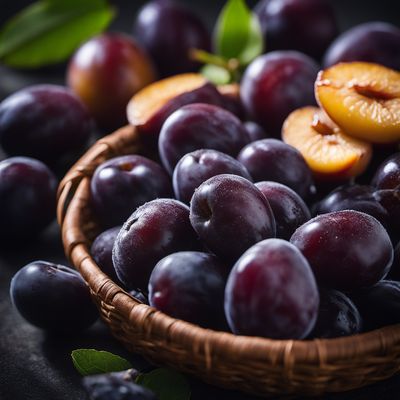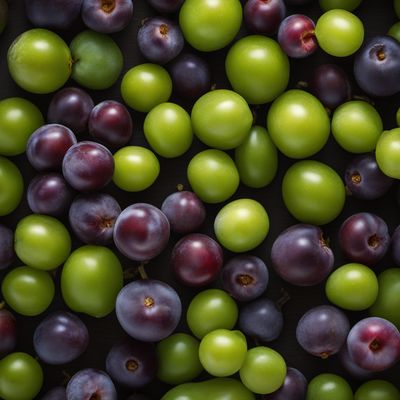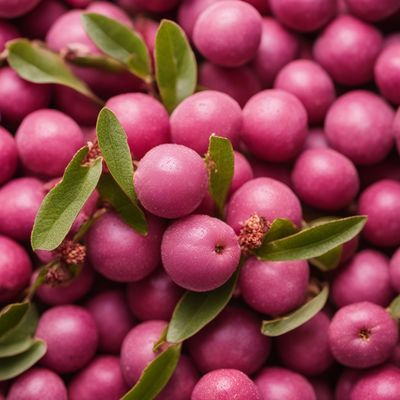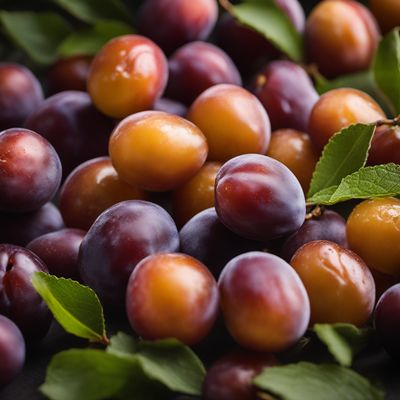
Ingredient
Sloes
The Bitter-Sweet Berry
Sloes are small, round berries with a deep purple or black color. They have a thin, tart skin and a juicy, slightly astringent flesh. The flavor of sloes is intensely bitter, with a hint of sweetness that develops as they ripen. The texture is soft and pulpy, and the berries contain a large stone in the center. Sloes are often used in the production of sloe gin, jams, jellies, and desserts.
Origins and history
Sloes are native to Europe and Western Asia, where they have been used for centuries in traditional medicine and culinary practices. They are primarily associated with the production of sloe gin, a popular liqueur made by steeping the berries in gin and adding sugar. Sloes have also been used in traditional British recipes, such as sloe jelly and sloe tart. In folklore, the blackthorn bush, which bears sloes, is believed to have protective and magical properties.
Nutritional information
Sloes are low in calories and fat, making them a relatively healthy ingredient. They are a good source of dietary fiber and contain small amounts of vitamins and minerals. However, due to their intense flavor and astringency, they are typically consumed in small quantities or used as a flavoring agent rather than eaten on their own.
Allergens
There are no known allergens associated with sloes.
How to select
When selecting sloes, look for berries that are plump, firm, and evenly colored. Avoid berries that are shriveled, moldy, or have signs of damage. The skin should have a slight bloom, indicating freshness. It is best to harvest sloes after the first frost, as this helps to soften their astringency and enhance their flavor. If purchasing from a store, look for fresh or frozen sloes in the baking or specialty section.
Storage recommendations
To maintain the freshness of sloes, store them in a cool, dry place or refrigerate them in a breathable container. They can also be frozen for long-term storage. If using fresh sloes, it is best to consume them within a few days. When using sloes in recipes, it is common to macerate or freeze them before use to soften their astringency and release their flavors.
How to produce
Sloes are typically foraged from the wild, as blackthorn bushes are commonly found in hedgerows and woodland areas. They can also be cultivated in home gardens, provided the climate is suitable. Blackthorn bushes require well-drained soil and full sun to thrive. They can be propagated from seeds or cuttings.
Preparation tips
Before using sloes, it is recommended to macerate them in alcohol or freeze them to soften their astringency and enhance their flavors. This process involves pricking the skin of the berries with a needle or freezing them overnight. Sloes are commonly used to make sloe gin, a popular liqueur that involves steeping the berries in gin and sugar. They can also be used to make jams, jellies, syrups, and desserts like pies, tarts, and crumbles. Sloes pair well with other fruits, such as apples, plums, and blackberries, and are often used in combination with them.
Substitutions
There are no suitable substitutions for sloes due to their unique flavor profile and culinary applications.
Culinary uses
Sloes are primarily used in the production of sloe gin, a popular liqueur. They are also used to make jams, jellies, syrups, and desserts like pies, tarts, and crumbles. In traditional British cuisine, sloes are often incorporated into recipes such as sloe jelly, sloe tart, and sloe gin cake. They can also be used as a flavoring agent in sauces, marinades, and glazes for meats.
Availability
Sloes are commonly found in Europe, particularly in the United Kingdom, where they are native. They can also be found in Western Asia and parts of North America. Sloes are often foraged from the wild or purchased from specialty stores or online retailers.
More ingredients from this category » Browse all

Prunus Nadia®
The Exquisite Fusion of Sweetness and Tartness: Prunus Nadia®

Chinese jujubes
The Ancient Fruit: Chinese Jujubes

American plums
The Sweet and Tart Delight: Exploring the World of American Plums

Damsons
The Prized Gems of the Plum Family

Plumcots
The Perfect Blend: Exploring the Unique Delights of Plumcots

Cherry plums
The Sweet and Tangy Delight: Exploring the World of Cherry Plums

Plums
The Juicy Gems

Gages
The Sweet and Succulent Delight: Exploring the World of Gages

Chickasaw plums
The Sweet Gems of the South

Japanese plums
The Delicate Delights of Ume: Unveiling the World of Japanese Plums

Mirabelles
The Golden Gems of Summer

Klamath plums
The Jewel of Klamath
